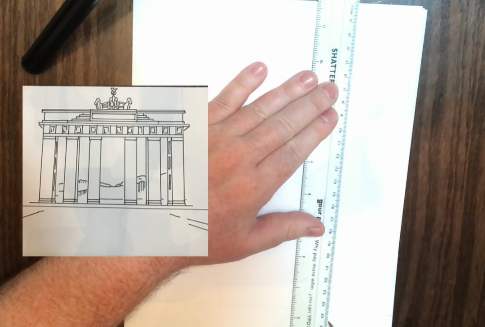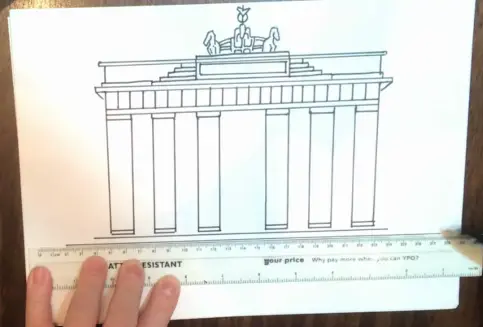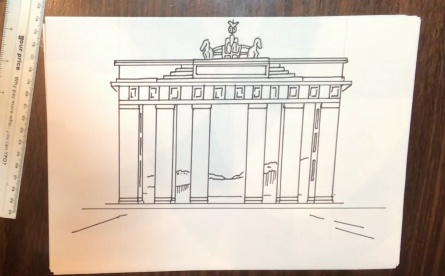Among the list of the most iconic manmade spectacles found throughout the world, the Brandenburg Gate has endured many historical events that included the invasion of Napoleon, the Second World War, a divided Cold War, and a triumphant return to unity, and finally a global tourism hotspot. Yet, learning how to draw the Brandenburg Gate is a history lesson within itself, combining many individual architectural styles.
You can find essential drawing equipment to complete this task here: Click here to view my basic equipment list.
Take a look at this online drawing course which will teach you how to draw perspective step by step and draw buildings accurately. Architectural Drawing: From Imagination to Conceptualization Click this link to visit Domestika
Drawing The Brandenburg Gate: Front View
The artistic style of the Brandenburg Gate is often considered Neoclassical-style that combines Greek column concepts called Doric columns. It also features prominent Romanesque styles that are mixed with ancient Greek mythology. But since you’re not going to be focusing on these tiny details, the overall shape is what most people see from a distance.
This is where you’ll need to have some decent photos to use as your primary source for reference. A great source is always one that allows you high-quality free downloads. This way, you can collect many images and angles that might appeal to you for artistic intent and dramatic impact.
Take a look at this online drawing course which will teach you how to draw perspective step by step and draw buildings accurately. Architectural Drawing: From Imagination to Conceptualization Click this link to visit Domestika
Drawing Basic Shapes
The overall shape of the Brandenburg Gate is a lot simpler than most architectural structures are going to be. The primary Doric columns make up most of the structure with a relatively easily crowned roof with the smaller statue positioned at the top. To draw these basic shapes will require using a straight ruler. If these lines are done by hand, a ruler will help keep straight lines once these are plotted out.
Checking The Proportions
The proportions are not too difficult to follow. The total length of the columns is 2 times the height of the upper crowned roof. In general, the total height of the Brandenburg Gate, including the Quadriga, is divided into two parts that start with the pillars and the upper crown and statue. When viewing the gate, this will be pretty obvious that the two sections are equal in height compared to each other.
These proportions will dramatically change when viewed closer, where angles of the gate become distorted and angular.
Begin To Add Details
The first lines you want to establish will depend on the angle with the most iconic view from the front. This allows you to keep the horizon line relatively low to the bottom of your drawing paper. This is then calculated to fit the total size of your gate. Which is based on the length of the columns. This is doubled, so the proportion matches the total height needed. The rest is eyeballing and making rough estimates for how wide the upper crown sits.
Six-columns
After looking at the get, it’s apparent that 6 columns are seen. Each of them is a mirror image of each other. The center spacing between the middle of the gate is slightly wider than the other columns. To draw these columns easier, you can draw three columns first using the total length of one column (as the spacing between columns 1 and 3). This is then traced and flipped to the opposite side to complete the columns.
The upper crown roof is separated into two levels that are equal in thickness. Where the center columns are placed will mark the upper platform where the Quadriga is sitting.
Quadriga: The Chariot Of The Gods
If you’ve never drawn Greek female statues or horses, this is going to be a good test for your drawing skills. I don’t always recommend tracing paper, but the easiest way to get the right shape is to place a printout photo of the Quadriga on the correct scale to your drawing over this spot. Rubbing graphite on the back of the picture will allow you to trace these figures without much effort. Cleanup after this is filling in the finer details.
Victoria: Roman Goddess Of Victory
The woman inside the chariot sitting at the top of the Brandenburg Gate is a Greek Goddess known as Victoria.
Not too many people know that she has wings since the view from below only shows her peeking out from between the 4 horses.
She will be easier to show standing in her chariot if you’re making a front view drawing. The highlights and shadows are very stark because the Quadriga and Goddess are constructed from brass.
Add Tone and Shadow
Another nice thing about the Brandenburg Gate is the amount of contrast from the various sections shown on each column is a mosaic of shades. The sun’s position will also play a significant role in where you place the shadows, so use your reference photos to fill these in. When it comes to the subtle tones, please use reference pictures to add tiny details.
If this is your first effort learning how to draw the Brandenburg Gate, choose the strongest image that illustrates the most dramatic shadows and contrast.
Even though the sandstone has been refurbished in recent years. Search for older pictures from the 1980s and 90s. To see how dirty and worn the surface stone has appeared before being cleaned.
Add Details
To give the finished draw an added sense of depth and realism consider adding additional detail to the six columns, including drawing the side of the individual columns.
Draw Background Features
Between the individual columns of the Brandenburg Gate, background, details, and features can be drawn, first lightly with a pencil and if you are more confident directly in pencil. This will give the drawing a greater sense of depth and authenticity.




